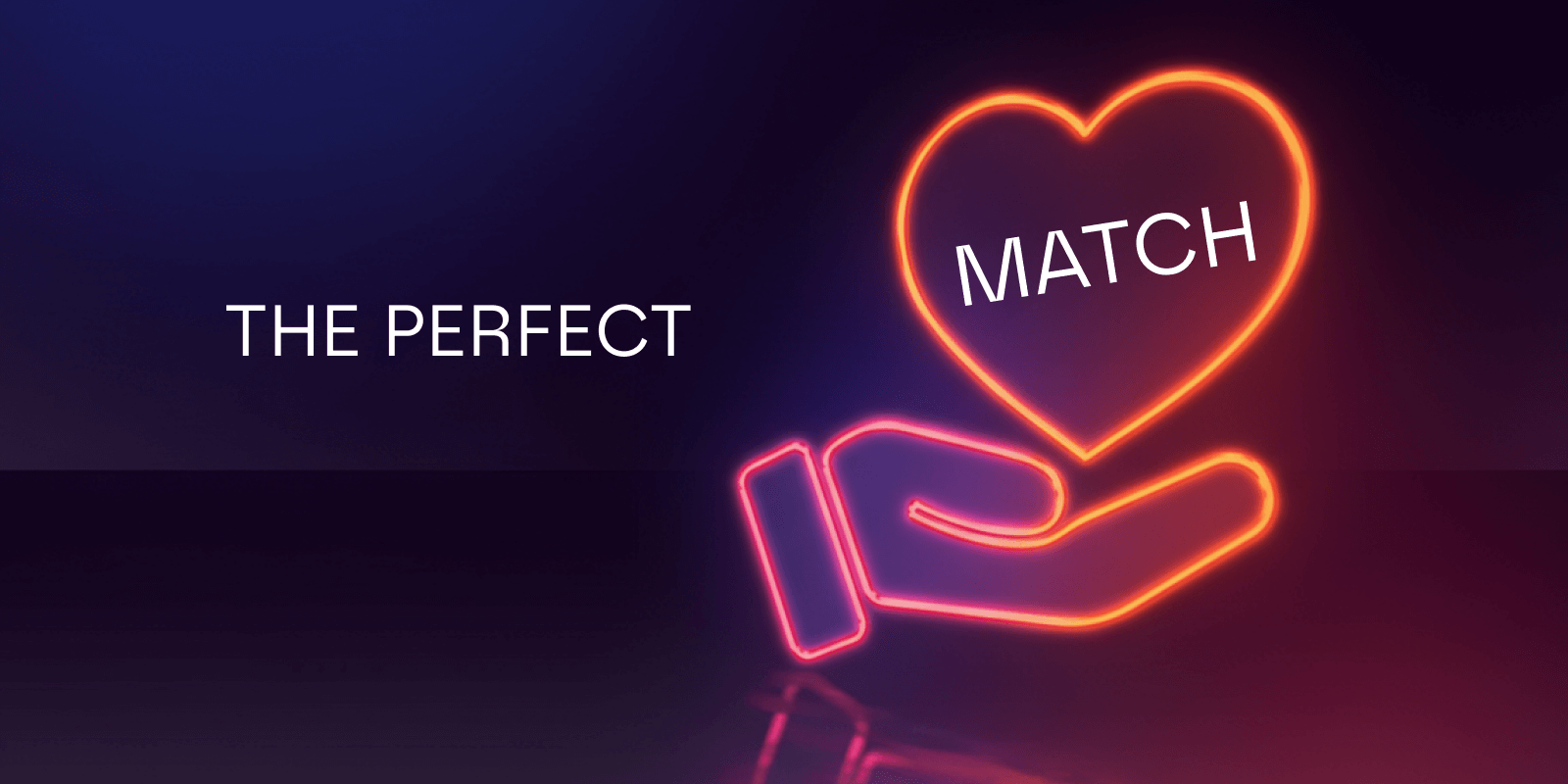When startups think about branding, the focus often leans heavily on design: logos, colors, and websites. But visual identity alone cannot carry a brand. Verbal identity (the way your company communicates through tone of voice, messaging, and statements) is equally important. For startups, aligning verbal and visual identity creates a consistent brand strategy that builds trust, attracts investors, and resonates with customers. This guide explains how to develop a verbal identity that matches your visual identity, why coherence matters for tech startups, and what best practices leading brands use to ensure consistency across every touchpoint.
What is the verbal identity and why does it matter for startups?
What is the visual identity and why does it matter for startups?
How do visual and verbal identity relate to the overall brand strategy?
How do I create a verbal identity?
Verbal Identity Example 1: Mailchimp
Verbal Identity Example 2: Bolt
Verbal Identity Example 3: Vidext
1. How do verbal identity and visual identity relate?
A startup´s brand identity is made up of what you visually perceive (visual identity) and what you read (verbal identity). Both, visuals and texts, combined build the foundation of your brand. For coherence and cohesion, it is crucial that they don't contradict themselves. These components need to be rooted in a strong brand strategy and, in the end, tie back to your USP and your mission, vision, and purpose.
To give you an (kind of) exaggerated example: Think about a company that sells baby clothing. The tone of voice (the verbal identity) is all soft, promising cute designs and natural fibers. The visuals? Dark green and grey tones, with edgy shapes and black-and-white photography. Quite off. Pastel tones and smooth shapes would probably work better.
1.1. What is the verbal identity and why does it matter for startups?
A strong verbal identity is the foundation of your brand communication and appeals to the emotions of the users, targets their weak points, and presents the solution in an approachable way, allowing consumers to capture benefits and understand the product easily. However, the importance of an aligned verbal identity is often only noticed when it's off. The second you stop reading and think: "What? I didn't get this." or "That sounds weird."
A strong verbal identity is characterized by:
Consistency: The tone, vocabulary, and rhythm don’t swing wildly between channels. Whether it’s a tweet, a press release, or packaging copy, it feels like the same “voice”.
Distinctiveness: It doesn’t sound like every other brand. Overused jargon or generic “friendly-but-professional” tone won’t cut it. Especially with ChatGPT, Jasper, Gemini, and friends, texts tend to sound the same (by the way, em-dashes aren´t always bad).
Authenticity: The voice feels true to what the brand stands for. If your brand promises rebellion, you can’t sound like a tax handbook. This relates back to your brand strategy.
Emotional resonance: It doesn’t just communicate information; it makes people feel something. Humor, warmth, boldness, elegance; whatever matches your brand’s character.
Clarity: Clever and creative is good, confusing is deadly. A strong verbal identity balances personality with straightforward communication.
When you work with a startup branding agency who also defines your verbal identity, you will most probably receive a Messaging Framework and Tone of Voice Guidelines. Both are closely tied ot your brand's personality, which they will previously define in a strategy exercise. Based on the Framework and the TOV, you can create the cornerstones of your verbal identity.
Let's break down the essentials:
Name
It all starts with the brand or product name, ideally being short, memorable, and unique. Don't know how to tackle this? Read our guide on creating a memorable and unique startup name.
Tone of Voice
Your Tone of Voice (TOV) is made up of your brand tone and brand voice. If you imagine your brand as a person, your voice would be the way you communicate in general, depending on your personality: some are friendlier than others, some use higher-register vocabulary while others are proud of their dialect. The Tone of Voice is typically made up of adjectives that emphasize how the company communicates and of adjectives that put certain limitations. For instance: "We are innovative and dynamic, but we're not over-promising." This means that while embracing disruption and progress, they keep their feet on the ground and communicate in a realistic way.
Mission and vision statements
As part of the brand strategy, both statements are essential guidelines for your startup and are of interest to stakeholders, investors, and talent. A mission statement outlines the fundamental purpose of the company, its primary activities, and the value it provides, concentrating on the present and answering the questions of “what”, “for whom”, and “how”. A vision statement articulates the company's long-term aspirations, goals, and the desired future state it aims to achieve.
Tagline
Just do it. You know which brand we are talking about, don't you? Well, Nike has definitely nailed its tagline. A catchy slogan or tagline, especially for consumer brands, connects your brand with the sector or your mission, facilitating brand recognition.
A tagline or slogan is part of a company's verbal identity, which can be defined as the language a company uses to describe anything related to its business, service, or product, including direct communication with customers.
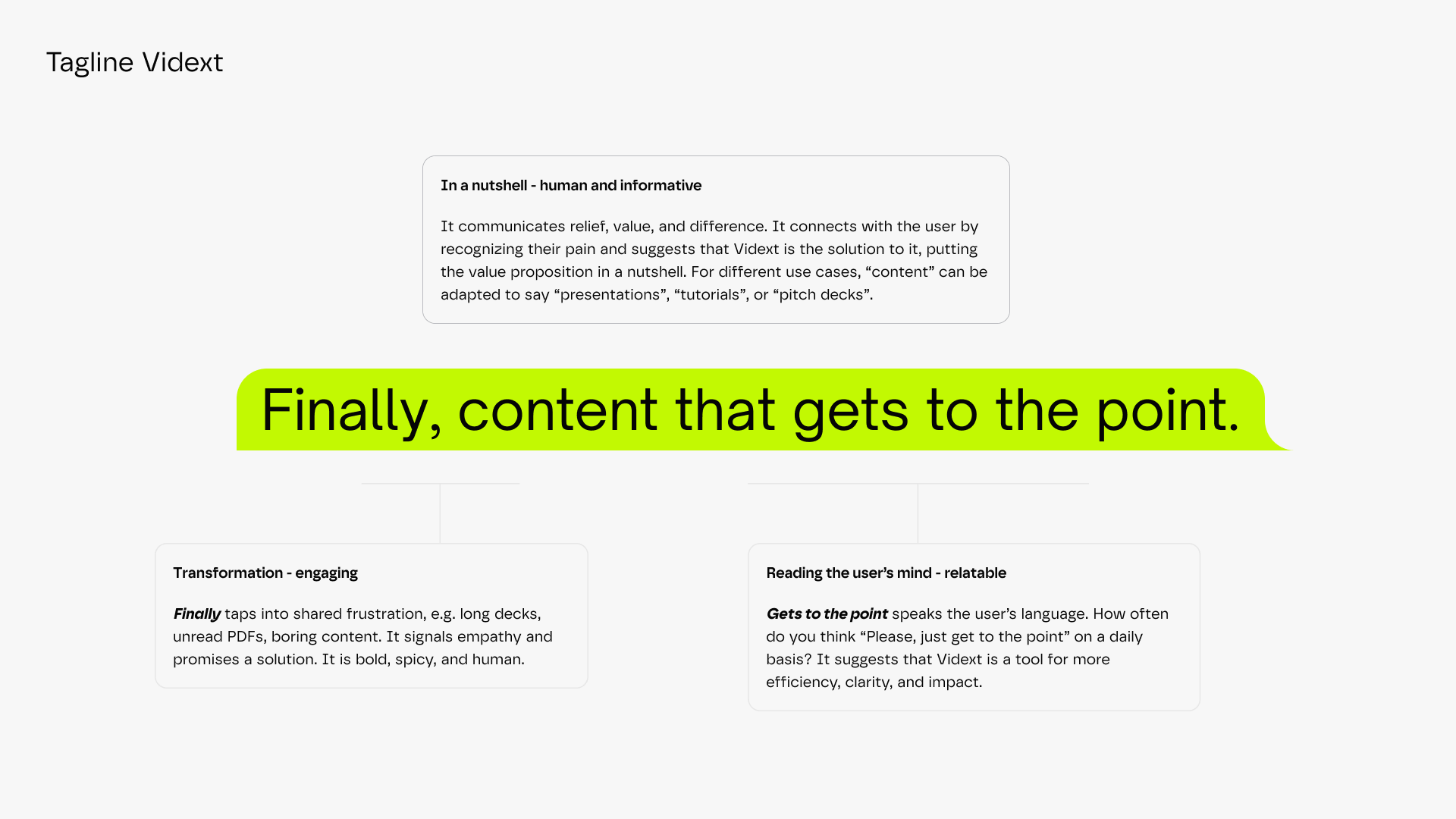
1.2. What is the visual identity and why does it matter for startups?
The visual identity of a company is the collection of design elements that make a brand recognizable and consistent across all touchpoints. It includes:
- Logo: The symbol or wordmark that expresses the brand’s core idea and works across applications. It is the primary identification element for a tech startup. Whether creating a new logo or revamping an existing one, it should be unique, easy to read and recognize, and can represent an imagotype (icon + logotype), isotype (icon), or a wordmark (logotype). Which type of logo you choose, is a strategic decision and also depends on the stage your company is at.
- Color palette: A set of primary and secondary colors that convey the company’s personality and values while ensuring flexibility. While certain industries have typical colors, choosing a palette that stands out from competitors can be beneficial. Not every financial service needs to be blue: the Fintech unicorn Klarna shines in a powerful pink, for instance.
- Typography: Fonts chosen for headlines, body copy, and digital use, balancing readability with distinctiveness. Less is more: the higher the readability, the better the font choice, for headings and body texts alike.
- Imagery: Photography, illustrations, or iconography that reflect the brand’s values, industry, and tone.
- Shapes and patterns: Branded elements that can be used in layouts, backgrounds, or animations to create cohesion.
- Motion and digital application: How the identity behaves on websites, apps, and animations, reinforcing recognition in interactive environments.
A startup's visual identity is how the brand strategy is expressed in design form. It ensures that whether users encounter the brand on a website, app, or social media, the look and feel are immediately recognizable and aligned with the company’s mission and values.
1.3. How do visual and verbal identity relate to the overall brand strategy?
Your brand strategy should be the starting point for each and every decision you make, whether it be on a verbal or visual level. Strong communication aligned to your strategy is as important for a Saas company as for a sportswear brand: it increases your customer loyalty, brand recognition, and communicates your value proposition clearly with easy-to-understand language and branded illustrations and animations.
Are you characterized by progress, playfulness, disruption, and idealism? Or do you lean towards tradition, seriousness, familiarity, and realism? These character traits shape your brand identity, both visually and verbally. For instance, a brand aiming for exclusivity and stability might opt for a more neutral style, while a vibrant and dynamic brand may embrace boldness and playfulness.
Build your brand strategy for free here.
2. How do I create a verbal identity? Your framework for success
After you've created your brand strategy, you can start working on your verbal and visual identity. This guide helps you to nail your messaging and Tone of Voice. Remember that everything is closely intertwined.
2.1. Who are you? Define your brand personality.
Your brand personality consists of a set of characteristics that are attributed to your brand or you want your brand to be perceived as.
First, from the table below, select the adjectives that you think describe (or in the future will describe) your brand best. Pick the three most important attributes and write them down. These will guide the direction of your verbal identity. For a SaaS startup that wants to reach a more elite audience, we have selected authoritative, innovative, and trustworthy in our brand strategy exercise.
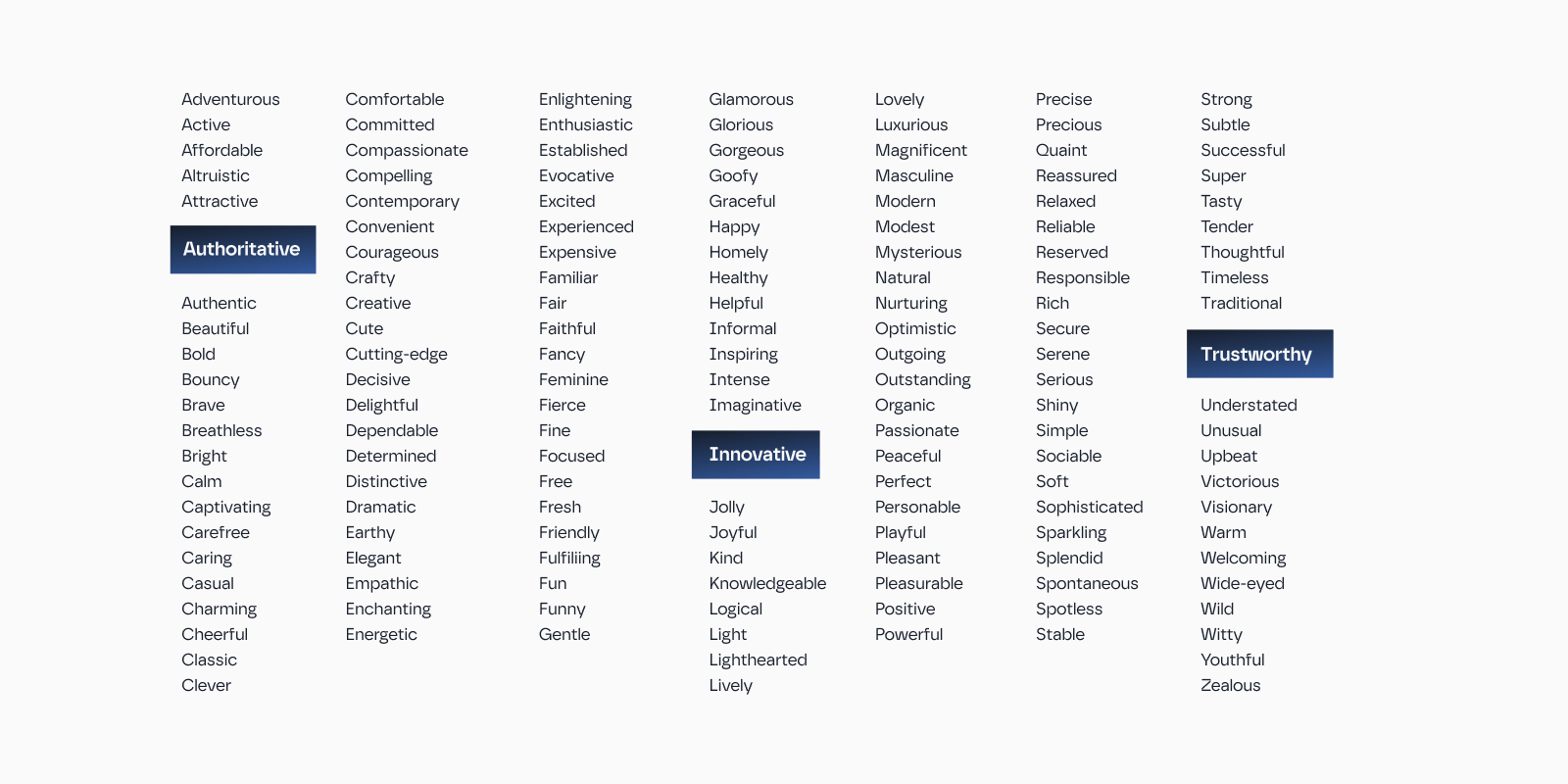
2.2. Who are you not? Set your tone of voice principles.
Have a look at your competitive landscape. What do you like about the communication style of your competitors? What don't you like about it? How can you be different and do it better than them? Maybe you like the friendly tone of competitor A in general, but think it is too fun for the intended target audience. Or you believe that competitor B communicates very clearly, but the style lacks some salsa...
Example: Competitor A: Friendly, engaging, but overly playful
Now, take the three adjectives from the first exercise as a starting point. Try to formulate three sentences saying what you are and to which extent, considering what extremes might put off your target audience. The analysis of your competitors above should have given you a feeling for certain limitations and areas of improvement. You can also combine two adjectives for the positive part of the sentence if you need to clarify your statement.
Example: We are reliable and trustworthy, but not bland.
2.3. How do you say it? Describe how you do it.
How do you have to communicate to reach your desired tone of voice? Outline Dos and Don'ts and give examples.
Example: Write positively.
Do: Our solution covers every detail of the process.
Don't: Our solution doesn't skip a single detail of the process.
For this purpose, keep in mind some brand communication principles:
Language register
This is a register of language used for a particular purpose or communicative situation. We often talk about register in terms of formality. Language register means for instance the use of industry jargon versus easy-to-understand vocabulary or Latin- and French-based words such as “status quo” versus phrasal verbs words such as “keep up to date”. Just compare the style of a business e-mail with a text message to your best friend.
On the spectrum below, you can see an example of a repositioning of a SaaS startup that was looking to establish a more elite tone of voice. Keeping in mind the "before" and "after" during the verbal identity exercise is crucial in order to align your language to your brand personality.
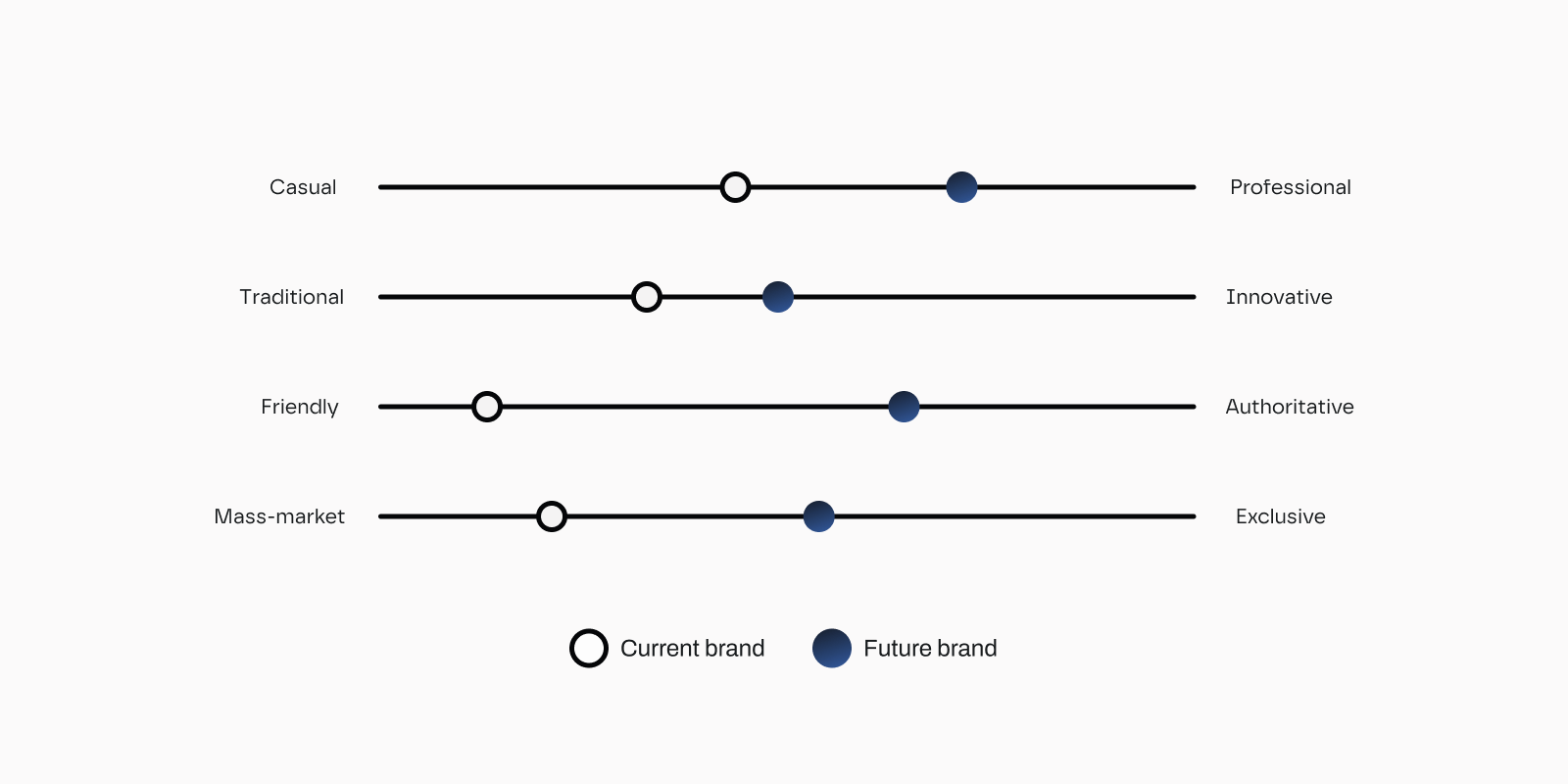
Some other points you should take into consideration for creating compelling copy:
- Punctuation also hints to your target audience: As a general rule, you shouldn't overdo it. Don't use too many dashes, exclamation marks, etc., independently of your tone of voice, to simplify the reading flow.
- Contractions such as “we're” instead of “we are” give off a friendlier and more approachable tone.
- Keep it short and sweet. The average internet user's attention span is 8.25 seconds. Readers tend to skim texts instead of reading details. Therefore, put the user benefits of your solution at the very beginning of your sentence and don't use filler words.
- Active or passive voice: Another differentiator between an approachable and an overly professional style is the use of active or passive voice. A communication style that addresses the reader directly and avoids passive structures is perceived generally as friendlier.
2.4. What do you say? Pin down your messaging pillars
Not only the way you talk, but also what you say matters: build your brand messaging pillars to align your communication with your strategy. Brand messaging typically consists of: your brand story, e.g. your mission, vision, purpose; your brand promise or tagline; and your messaging pillars.
For your mission, vision, and purpose statements, keep in mind that they should be short and encapsulate the essence of your business. You will need them for company presentations, pitch decks, or your About page on your website.
Mission: What, who, why you?
The mission statement formulates the value proposition. It summarizes the specific benefits that customers experience when they use the services of the company. The mission statement functions as an elevator pitch that piques curiosity, articulating the value that customers experience through purchasing products or collaborating with the company. Therefore, it is primarily directed toward customers, partners, and other stakeholders.
Example (IKEA): To offer well-designed, functional, durable, affordable, and sustainable home furnishing solutions to people with big dreams and thin wallets.
Vision: Where to?
The company's vision is a concrete goal you aim to achieve within a defined timeframe. The vision statement is primarily directed toward the company's own employees and encompasses the goal that the company aims to achieve in the medium term. The vision serves as a guiding star and is intended to motivate employees to position the brand successfully in the future.
Example (IKEA): To create a better everyday life for the many people.
Purpose: The big WHY?
A brand's purpose is the reason why. It could address an existing issue or enhance the lives of your end users by making them better or easier. Reflect on how your brand, product, or service positively impacts the lives of those who utilize it. This constitutes your brand's purpose.
Example (IKEA): We want to have a positive impact on the world – from the communities where we source our raw materials to the way our products help our customers live a more sustainable life at home.
Tagline: Short and sweet
Your brand promise or tagline is even shorter, needing it to be more creative. Carefully think about each word and don't overcomplicate it.
Examples
Apple: Think differently.
Nike: Just do it.
Vidext: Content that gets to the point.
Messaging Pillars and Key Differentiator: What sets you apart?
Companies often establish three factors that they create communication around, the brand messaging pillars. These act as brand promises, highlighting your capabilities and their benefits for the end user. Whether you are using next-gen technology or you have flexible solution models, this needs to be kept in mind for your storytelling.
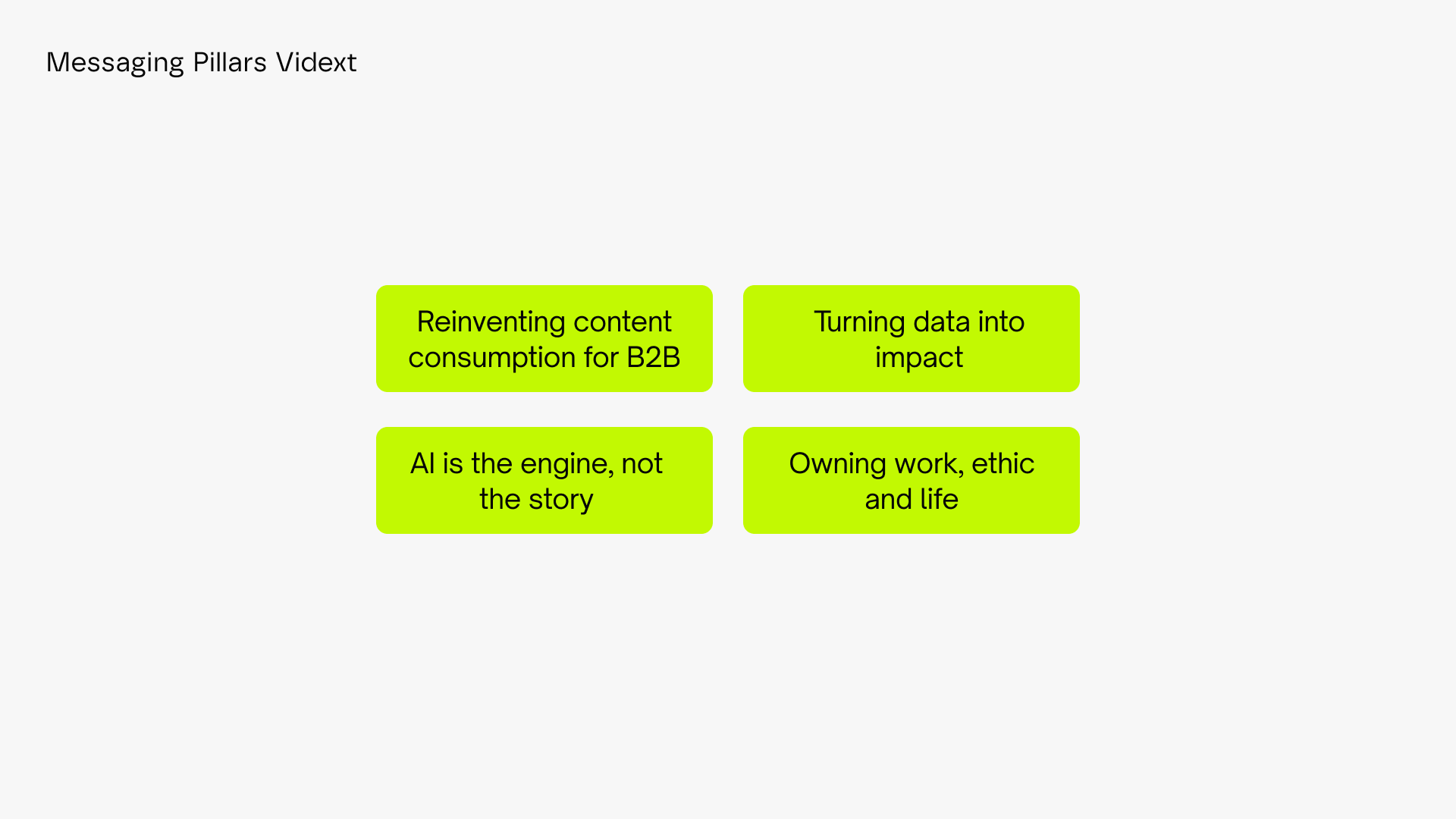
Remember that they need to be provable and relevant to your potential clients. The more niche your solution or product, the easier it will be to stand out.
For your verbal identity, defining your messaging pillars and your key differentiator is crucial, as it will frame the topics you will focus on. Also when building your visual identity, it's important to keep your key differentiators in mind to communicate your value proposition clearly and consistently within different brand assets.
At this stage, you have already defined the key factors of the messaging framework for your company. Ideally, you summarize it in order to keep it in mind during the whole process.
2.5. Be consistent and pay attention to details: Brand Grammar
The least creative and most technical step is creating a Brand Grammar, which you can use as a reference whenever you write texts and have doubts about spelling, capitalization etc. It helps create consistency across your texts and fosters trust and a professional brand image.
It should include:
- Abbreviations & acronyms: when to write out unfamiliar abbreviations or acronyms.
- Capitalization: when and what to capitalize, especially important for titles and headings.
- Emojis: where they are (in)appropriate for your brand.
- Numbers: when to spell out numbers.
- British versus American English: which spellings, vocabulary, and formatting options you use, depending on your target market.
For reference, you can also use the AP Style Guide for American or the Oxford Style Manual for British English.
2.6. Examples
For copy guidelines that really work for your team, make sure to include examples and information why you're choosing certain words over others or why you've changed old wordings. Try the TOV for different channels; like the hero section of your homepage, a Trust section, or a LinkedIn posting.
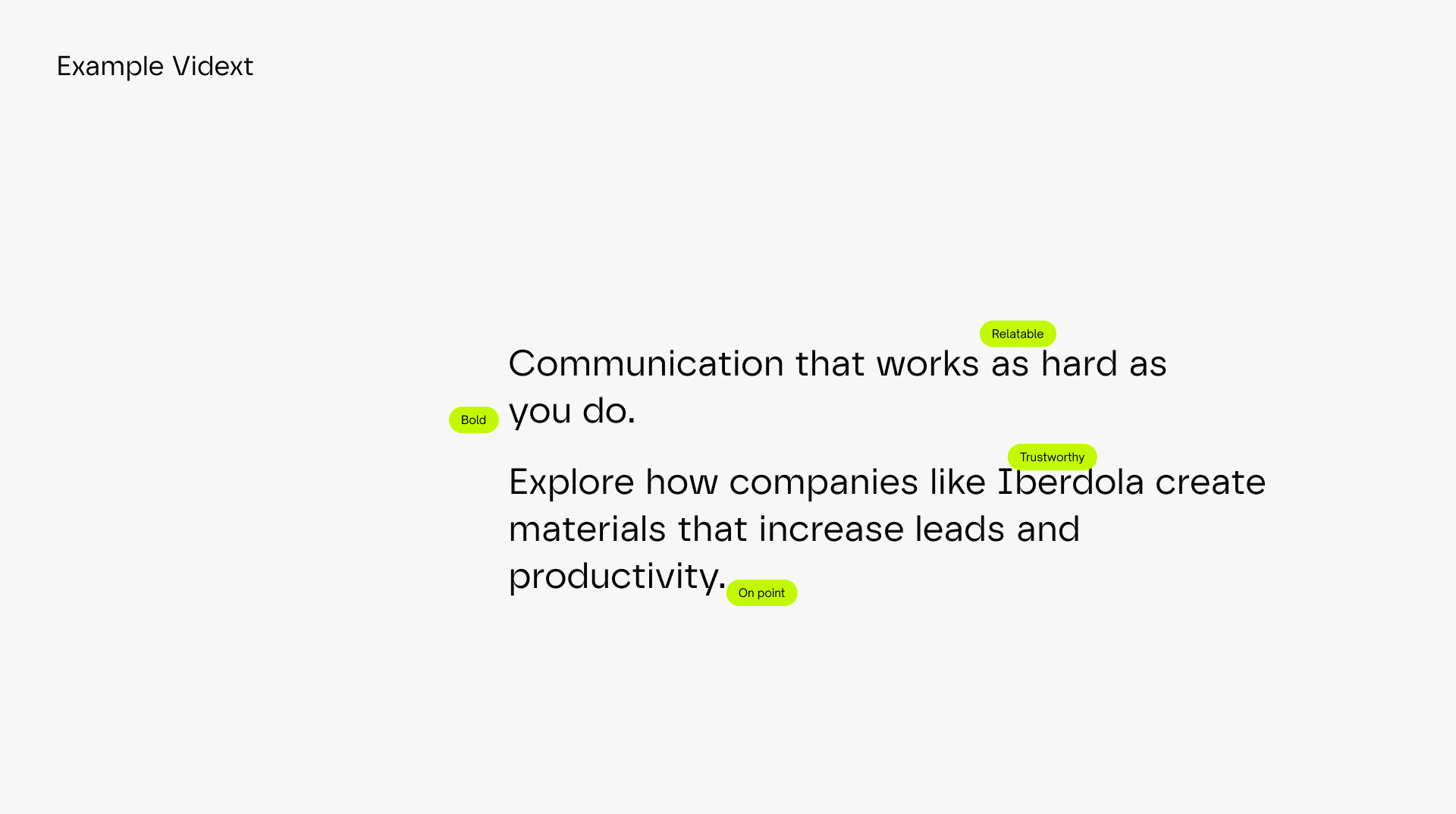
2.7. Align your visual and verbal identity
Congratulations! You've successfully created your verbal identity!
Ideally, you design your visuals at the same time you build your verbal identity. That way, you make sure to create cohesive branded storytelling. Especially for your website, this step is important: When illustrations match and strengthen your headline and speak to your audience in the same voice, you will significantly increase user experience. Vice versa, if the wording of your call to action establishes a direct relationship with its design, it will be more appealing to users.
Check out the best practices below and also learn how to make it right for your SaaS brand.
3. Verbal identity examples: A deep dive into industry-leading examples
3.1. Mailchimp: Businesses talk, but with a wink
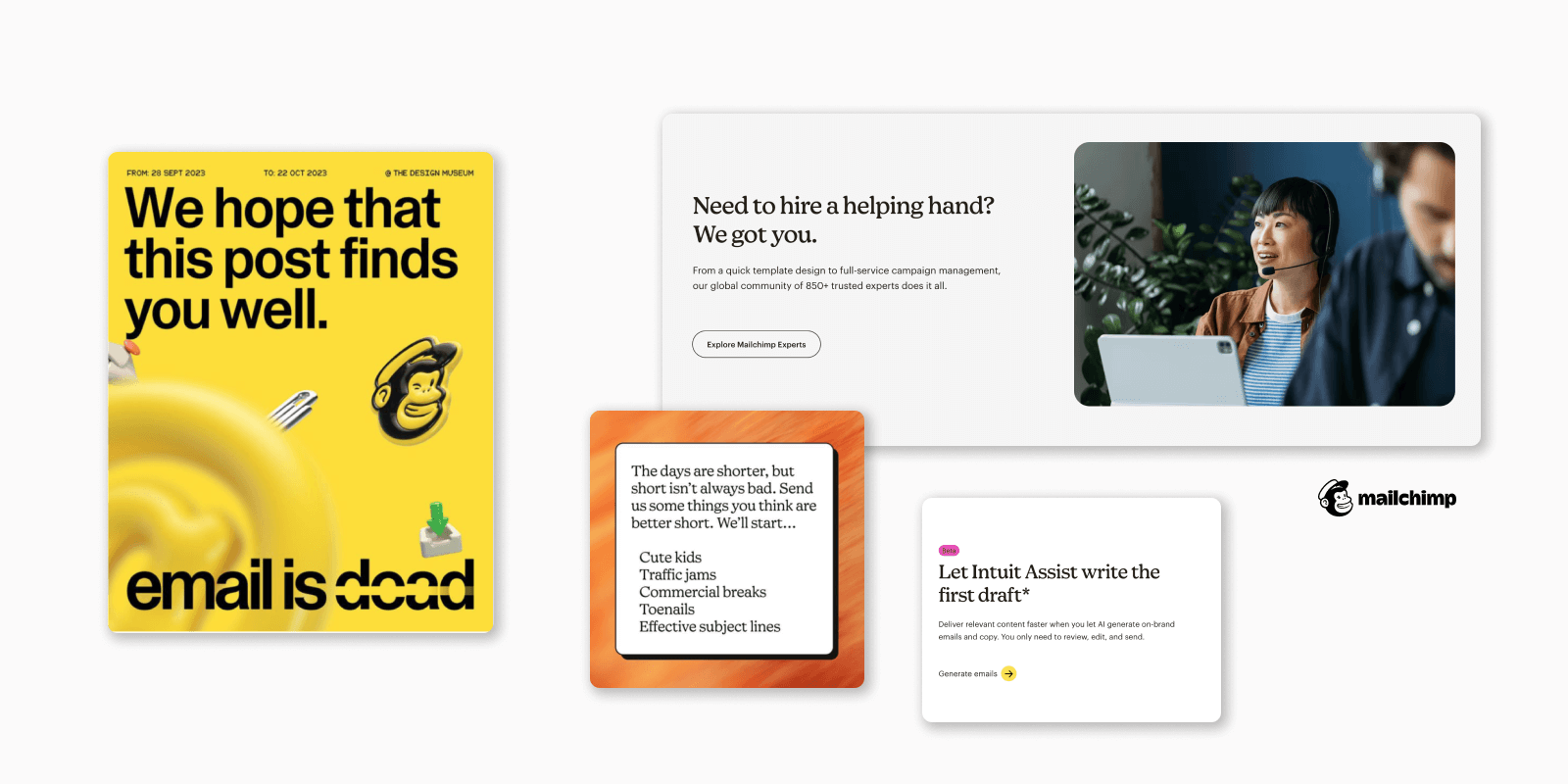
Although the marketing automation and e-mail marketing platform is targeted at a business audience, Mailchimp always communicates with a hint of playfulness and a big smile.
Mailchimp has developed a brand with a strong personality and an original identity. In addition to its distinctive illustrations, unique color palette, and typography, they have crafted a genuine and authentic brand voice.
In their Tone of Voice guidelines, they describe themselves as plainspoken, genuine, and translators with dry humor—this is clearly visible across different channels. Using offbeat humor and a conversational voice, Mailchimp plays with language and engagingly communicates dry marketing topics, translating B2B topics to a broad audience. However, they don't overdo it: they know that businesses come to Mailchimp to get work done and refrain from distractions in their verbal communication.
Their Instagram feed is loud and fun, filled with dry humor that resonates with the targeted users: postings in the communicative style of the screenshot gain the most likes.
Depending on the platform, their tone varies slightly: obviously, they are more fun or outgoing on social media than on marketing landing pages. Still, the essence of their voice remains the same. CTA headlines like Need to hire a helping hand? We got you. are friendly, plainspoken, and inviting. Also, they tweaked it to make it a rhetorical figure “hire (a) helping hand”: three words in a row that start with the same letter, linguists call this Alliteration. This helps make phrases easier to remember and appeals to readers.
3.2. Bolt: The company name says it all
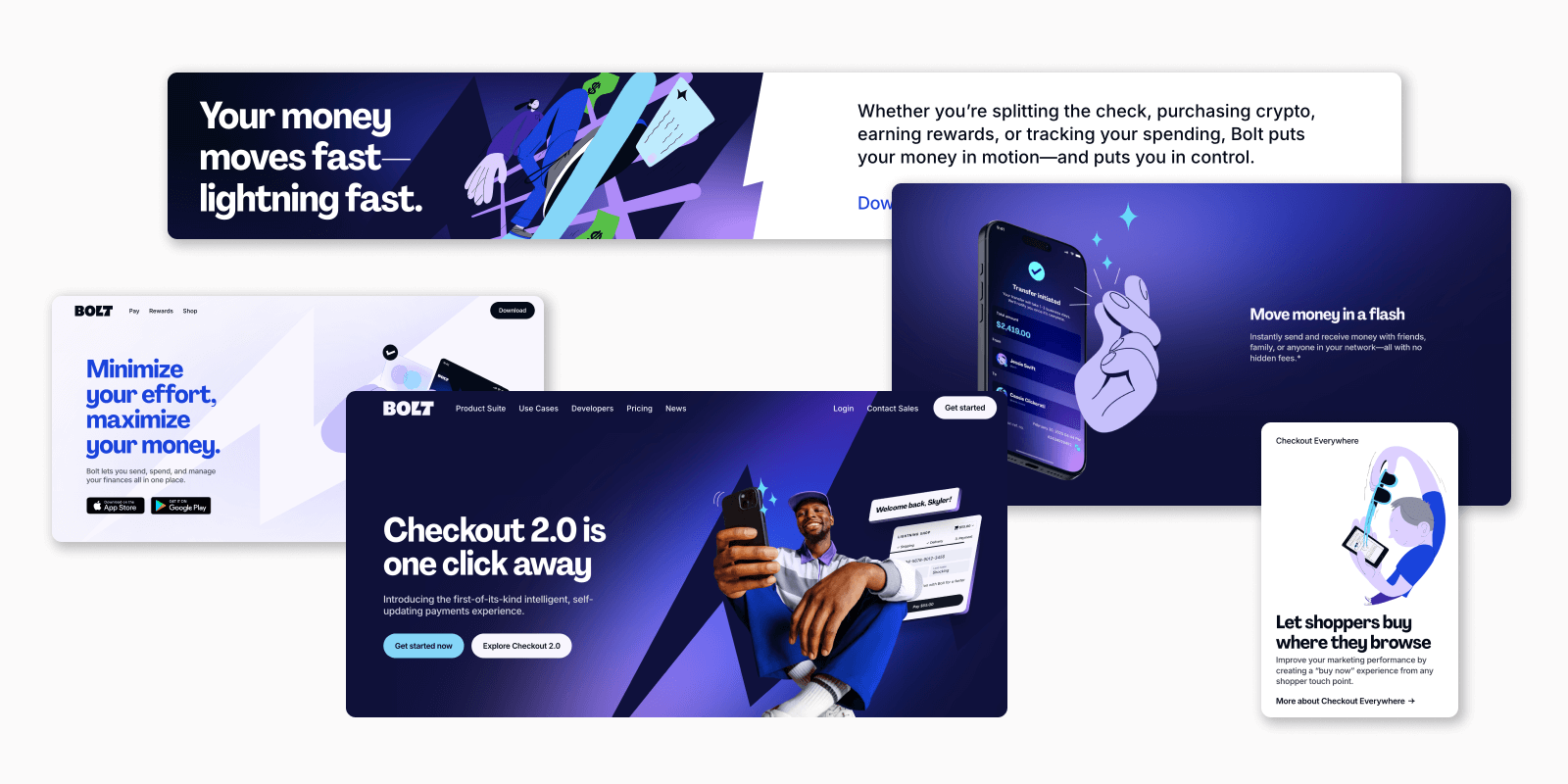
When the company name is indicative of the whole brand identity: Bolt. Bolt is a checkout experience platform, connecting shoppers to retailers in a unified cross-brand network. Needing to communicate a complex tech product, they try to reduce tech talk to the bare minimum.
Bolt puts user benefits at the center of their communication and swiftly combines copy and imagery, always trying to make a direct connection between verbal and visual impact.
In their Tone of Voice Guidelines, they describe themselves as thoughtfully concise, knowingly playful, and comfortably at ease. This is true for sure—across their website, on the merchant and shopper section, Bolt uses short phrases, and playful language, appealing to the audience. Whereas the body text is more descriptive and toned-town, the headings are creative and on-point, using rhetorical devices such as:
- Alliterations (words starting with the same letter): Shockingly simple shopping.
- Tricolons (three short words in a row): Browse. Click. Buy.
- Antithesis (combination of two opposing concepts): Password hint: Forget it
- Metaphors (symbolical description): Lightning-fast checkout
3.3 Vidext: Owning the content
Vidext offers tools for corporate communication to make it more engaging, measurable, and efficient. Its verbal identity is built around clarity, confidence, and a human touch. The SaaS startup avoids technical jargon and puts user outcomes at the center: faster creation, smarter communication, and measurable impact.
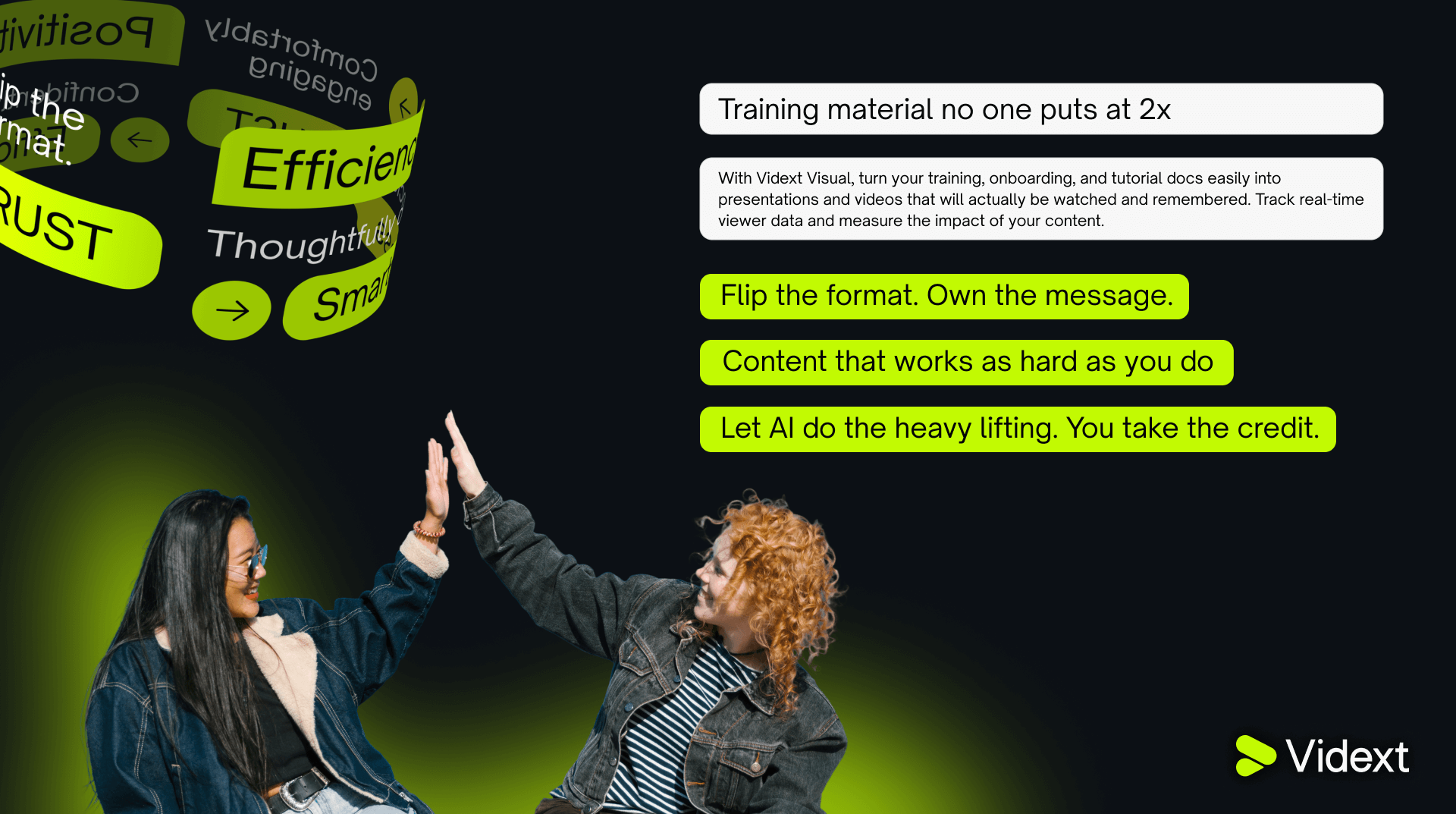
Across their website, product pages, and campaigns, Vidext combines practical, on-point phrasing with empathetic language that recognizes users’ daily struggles. In this brand strategy and brand communication exercise, we built the messaging framework around four pillars: Reinventing content consumption for B2B; Turning data into impact; Owning work, ethic and life; AI is the engine, not the story.
Content creators feel like tasks are getting out of their hands. For the Vidext project, it was all about Ownership: owning the content, the technology, your life. This equips users with confidence and gives them back a piece of freedom.
Rhetorical devices add rhythm and memorability: contrast (“Less buzz, more biz”), anaphora (repeating structures for focus), and relatable references (“Because nobody asked for slide 87”). The result is a brand voice that feels like an ally—transparent, inspiring, and actionable—helping teams not just create content, but own their message with confidence.
TL;DR?
Building coherence between verbal and visual identity is not a finishing touch, it is the foundation of startup branding. A clear brand strategy that connects language with design helps startups communicate their value proposition, differentiate in competitive markets, and grow with consistency.
Even as a SaaS startup you can get creative with your verbal and visual identity without compromising professionalism, technology, and innovation. However, the direction your branding is going always depends on the look and feel you want to establish and be in line with your brand strategy.
For tech startups, working with a specialized startup branding agency ensures that both strategy and execution are aligned: from naming and messaging pillars to logos, typography, and web design. If your goal is to establish a strong brand identity that scales, our team at The Branx helps startups transform strategy into words and visuals that work together.
Sources:
Bolt Media Kit and Brand Guidelines
Mailchimp: Tone of Voice Guidelines
